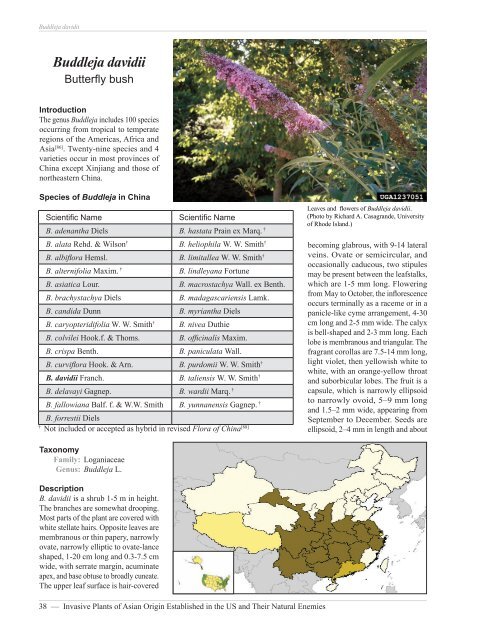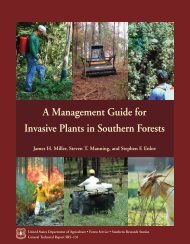Buddleja davidii
Buddleja davidii
Buddleja davidii
Create successful ePaper yourself
Turn your PDF publications into a flip-book with our unique Google optimized e-Paper software.
<strong>Buddleja</strong> <strong>davidii</strong><br />
<strong>Buddleja</strong> <strong>davidii</strong><br />
Butterfly bush<br />
Introduction<br />
The genus <strong>Buddleja</strong> includes 100 species<br />
occurring from tropical to temperate<br />
regions of the Americas, Africa and<br />
Asia [86] . Twenty-nine species and 4<br />
varieties occur in most provinces of<br />
China except Xinjiang and those of<br />
northeastern China.<br />
Species of <strong>Buddleja</strong> in China<br />
†<br />
Not included or accepted as hybrid in revised Flora of China [88] ellipsoid, 2–4 mm in length and about<br />
Leaves and flowers of <strong>Buddleja</strong> <strong>davidii</strong>.<br />
Scientific Name<br />
Scientific Name<br />
(Photo by Richard A. Casagrande, University<br />
of Rhode Island.)<br />
B. adenantha Diels B. hastata Prain ex Marq. †<br />
B. alata Rehd. & Wilson † B. heliophila W. W. Smith †<br />
becoming glabrous, with 9-14 lateral<br />
B. albiflora Hemsl. B. limitallea W. W. Smith † veins. Ovate or semicircular, and<br />
occasionally caducous, two stipules<br />
B. alternifolia Maxim. † B. lindleyana Fortune<br />
may be present between the leafstalks,<br />
B. asiatica Lour. B. macrostachya Wall. ex Benth. which are 1-5 mm long. Flowering<br />
from May to October, the inflorescence<br />
B. brachystachya Diels B. madagascariensis Lamk.<br />
occurs terminally as a raceme or in a<br />
B. candida Dunn B. myriantha Diels<br />
panicle-like cyme arrangement, 4-30<br />
B. caryopteridifolia W. W. Smith † B. nivea Duthie<br />
cm long and 2-5 mm wide. The calyx<br />
is bell-shaped and 2-3 mm long. Each<br />
B. colvilei Hook.f. & Thoms. B. officinalis Maxim.<br />
lobe is membranous and triangular. The<br />
B. crispa Benth. B. paniculata Wall.<br />
fragrant corollas are 7.5-14 mm long,<br />
B. curviflora Hook. & Arn. B. purdomii W. W. Smith †<br />
light violet, then yellowish white to<br />
white, with an orange-yellow throat<br />
B. <strong>davidii</strong> Franch. B. taliensis W. W. Smith †<br />
and suborbicular lobes. The fruit is a<br />
B. delavayi Gagnep. B. wardii Marq. †<br />
capsule, which is narrowly ellipsoid<br />
B. fallowiana Balf. f. & W.W. Smith B. yunnanensis Gagnep. †<br />
to narrowly ovoid, 5–9 mm long<br />
and 1.5–2 mm wide, appearing from<br />
B. forrestii Diels<br />
September to December. Seeds are<br />
Taxonomy<br />
Family: Loganiaceae<br />
Genus: <strong>Buddleja</strong> L.<br />
Description<br />
B. <strong>davidii</strong> is a shrub 1-5 m in height.<br />
The branches are somewhat drooping.<br />
Most parts of the plant are covered with<br />
white stellate hairs. Opposite leaves are<br />
membranous or thin papery, narrowly<br />
ovate, narrowly elliptic to ovate-lance<br />
shaped, 1-20 cm long and 0.3-7.5 cm<br />
wide, with serrate margin, acuminate<br />
apex, and base obtuse to broadly cuneate.<br />
The upper leaf surface is hair-covered<br />
38 — Invasive Plants of Asian Origin Established in the US and Their Natural Enemies
0.5 mm in diameter, with long wings<br />
at both ends [88][86] .<br />
Habitat<br />
B. <strong>davidii</strong> occurs in thickets on hillsides<br />
and trenches, at elevations of 800-3,000<br />
m [86] .<br />
Distribution<br />
B. <strong>davidii</strong> occurs in Anhui, Gansu,<br />
Guizhou, Henan, Hubei, Hunan, Jiangsu,<br />
Jiangxi, Shaanxi, Sichuan, Yunnan,<br />
Zhejiang, and possibly Guangdong<br />
[26][31][50][88][86][156][162]<br />
.<br />
Economic Importance<br />
The entire plant is used medicinally.<br />
Fragrant essential oils can be extracted<br />
from the flower. It is also grown as an<br />
ornamental plant for its graceful flowers<br />
and down-swept twigs [86] .<br />
<strong>Buddleja</strong> <strong>davidii</strong><br />
Natural Enemies of <strong>Buddleja</strong><br />
Three fungi and thirteen arthropods are<br />
reported for <strong>Buddleja</strong> speceis. One fungal<br />
species, Pseudocercospora buddleiae,<br />
is reported to infect B. <strong>davidii</strong>.<br />
Fungi<br />
Phylum Family Species H. R. Ref.<br />
Ascomycota Meliolaceae Irenina buddlejae Hansf. oo 23<br />
Anamorphic Mycosphaerella<br />
Pseudocercospora buddleiae (W. Yamam.) Goh &<br />
W.H. Hsieh<br />
oo 23 †<br />
o 110<br />
Septoria merrillii Syd. mo 23<br />
†<br />
Recorded as Cercospora buddlejae Yamam<br />
Arthropods<br />
Order Family Species H. R. Ref.<br />
Coleoptera<br />
Homoptera<br />
Chrysomelidae<br />
Pseudococcidae<br />
Hemipyxis lusca (Fabricius) po 185<br />
Hemipyxis plagioderoides (Motschulsky)<br />
po 65<br />
po 158<br />
Hemipyxis tonkinensis (Chen) po 185<br />
Hespera bipilosa Chen et Wang oo 140<br />
Hespera univestis Chen et Wang oo 140<br />
p 65<br />
Stenoluperus nipponensis (Laboissiere)<br />
po 140<br />
po 158<br />
Trachyaphthona bidentata Chen et Wang<br />
oo 140<br />
oo 185<br />
Trachyaphthona buddlejae Wang po 185<br />
Trachyaphthona cyanea (Chen)<br />
oo 140<br />
po 185<br />
Trachyaphthona fulva Wang oo 140<br />
Pedronia planococcoides Borchsenius po 150<br />
Planococcus sinensis Borchsenius po 150<br />
Thysanoptera Thripidae Dendrothrips stannardi (Ananthakrishnan) po 56<br />
Invasive Plants of Asian Origin Established in the US and Their Natural Enemies — 39

















